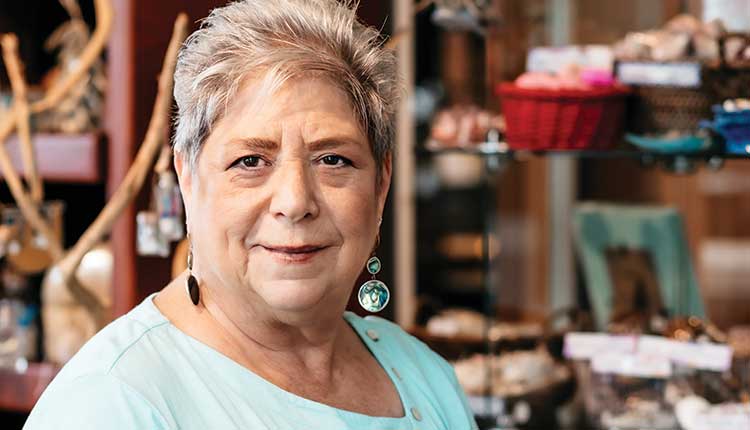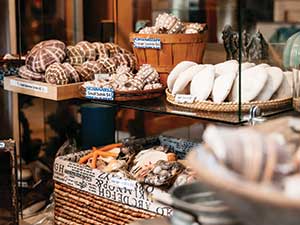Cave stores: More than a store |
| By Christine Schaffran |
|
|
Displaying the merchandise is just as important as showcasing relics and artifacts that tell the story that visitors come to see. Rumor has it that L. Frank Baum once visited in the 1930s. When “The Wizard of Oz” writer descended the tunnel that took two Chinese immigrants five months to chisel with a pick ax and a shovel, he marveled how the cave silhouette resembled Sunny Jim, a cereal mascot used to sell Wheat Flakes. “The silhouette was really very similar,” says Patrice Forrister, the buyer for The Cave Store. “But in the ’80s, the rock fell and formed [more of] a chin, but before, he really looked like Sunny Jim. And that’s how he got his name.” Made for merchandisingThe Cave Store is more than the final destination to collect souvenirs and gifts before heading home — it’s the destination. And with a history as storied and unique as this, the souvenirs had better be, too.“We try to get very unique shells, or at least I try to get statement pieces. I do have a girl that works on the shells since I can’t do that, too,” Forrister admits. The San Diego County resident, who has had her hand in retail for nearly 40 years, worked in legendary stores such Saks Fifth Avenue and the now-defunct Silver Skillet, and intuitively knows a good buy when she sees one.  The Cave Store stocks a unique selection of shells and other statement pieces for customers. “I price everything realistically,” she notes. “I’ve got a history long enough to know what things are worth.” Anywhere from 300 to 600 customers pass through the doors daily to lay claim to sought-after finds. Items like wooden praying Buddha cats and dogs, essential oils, geodes, kimonos, hand-drawn stickers, dried flower earrings and pieces from Guatemala are the more unique souvenirs that Forrister really prides herself on. “I try to find companies that give back and donate money to research,” she says. “And we love name-drop items.” For new-age and metaphysical product designers, Forrister turns to Benjamin International. Show and tellBut it’s not just the items for sale that Forrister believes captivates customers. Displaying the merchandise is just as important as showcasing relics and artifacts that tell the story that visitors come to see.“I just try to make sure that [the displays are] aesthetically pleasing. You don’t want a whole bunch of ducks in a row,” she advises. “You want people to come in and see the items and say, ‘Wow, I really need that.’ And good-looking displays make a huge difference. They really do.” Tantalizing displays alone won’t always sell merchandise. Sometimes it takes help from unique settings or props. “You want people to come in and see the items and say, ‘Wow, I really need that.’ And good-looking displays make a huge difference. They really do.” — Patrice Forrister“We have a very eclectic mix of furniture and a lot of beautiful antiques that we use as displays,” Forrister says. “It’s very unconventional.” A storied pastIn 1902, a German artist named Gustave Schultz hired immigrants to mine a tunnel from The Cave Store down through the sandstone cliffs of La Jolla Cove and into Sunny Jim’s Sea Cave, according to the gift shop website. The Cave Store stocks a unique selection of shells and other statement pieces for customers. Photos: Robyn Scherer Photography
“It’s been said that during Prohibition, bootleggers smuggled alcohol and opium into San Diego through the sea cave by carrying it through this tunnel,” the website explains. Among the 15 employees milling about in the gift shop every day is Tim Gonzales who runs “the line” of guests waiting to descend into the sea cave. “Tim, he’s our sole guy, he’s been here for 16 years,” Forrister notes. “He knows everything about the cave. He’s been a local for a long time.” Artistic finds“We do really well with our jewelry. We have two girls that also make jewelry for the owner and [people] get excited because they’re one-of-a-kind pieces,” Forrister notes.Forrister says she also tries to support and buy local and in-state with SF Mercantile, with the “SF” being short for “San Francisco.” A debt of gratitudeForrister credits the owner, Shannon Smith, for allowing her to use creative freedom in creating displays and other showstoppers for the last 15 years. Smith took over as owner after her husband, Jim, passed away.Forrister adds that she’s proud of the work that she’s done in “bringing in new products and figuring out what the people want and what they want to fly home with,” but she’s even happier to see local residents buying and shopping in the gift shop. “It’s just such a great place,” Forrister says. “I’m really, really lucky that I landed here.” |
